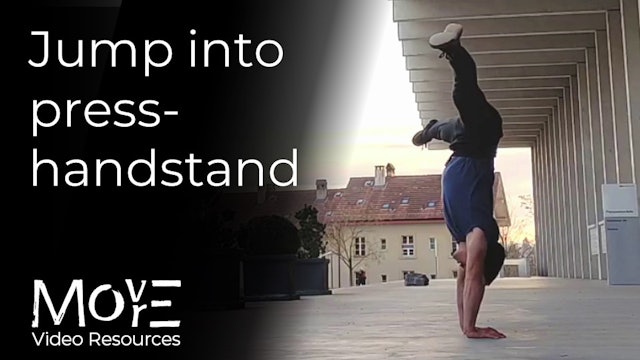Handstand entry & exit
Before being able to balance in a handstand, you must learn to enter. Generally an certain entrance is chosen because it is conducive to the specific balancing form which follows. E.g. a straight-leg kick-up into straight-line allows for immediate alignment of the legs, as well as travelling the further distance to "stack" on top of the body. A two-footed jump into tuck HS facilitates "catching" in the bent-knee position and keeping the centre of mass low. Investing practice in handstand entrances will ultimately make the practice of static balance much more productive.
This is because an inefficient/inconsistent handstand entrance costs energy which ultimately determines the extent of your handstand practice (fatigue ultimately leads to breakdowns in form, and practice in such as state is counter-productive). Having a consistent kick-up, then, (generally determined as achieving a baseline of '5/5' or a solid foundation of '10/10' successful entrances, holding the balance form for just a few moments), allows you to practice for longer as you are essentially spending more time in the balancing form and less trying to enter into it.
LEARN MORE (subscriber-only):
Ihttps://drive.google.com/file/d/14HrGgYzXziFqFWUi7VYoAeK7BhOyOyuK/view?usp=drive_link
-
Jump to tuck-handstand (reps)
THE WHAT & WHY:
A simple context for developing the consistency of your jump into tuck-HS form. The objective is to develop EFFICIENCY: the jump-up should feel as easy as possible, use as little energy as possible, make as little noise as possible on landing and use the REBOUND to re-enter the ne... -
Learning to fall from the Handstand
FEAR MANAGEMENT:
For inverted practice toward the handstand to be the most effective, FEAR must be respected and effectively managed. And as this fear is not necessarily due to being inverted, but rather the fear of from FALLING from inversion, we can overcome this by developing both effective to... -
Handstand kick-up to wall
THE WHAT:
The 'kick-up to wall' must be developed before the practitioner can effectively practice both supported-alignment and supported-balance back-to-wall drills. A common misconception is that the inability to kick-up to wall is due to a lack in strength, however, this is rarely the case.M...
-
Kick-up to straight-line handstand (reps)
THE WHAT & WHY:
A simple context for developing the consistency of your kick-up into straight-line HS. The objective is to develop EFFICIENCY: the kick-up should feel as easy as possible, use as little energy as possible, make as little noise as possible on landing and use the REBOUND to re-enter... -
Jump into press HS
THE WHAT:
Whilst this context does not significantly contribute to the straight-arm strength required to perform the full 'Press handstand', it allows development of the "popping" texture required for an efficient jump-up into straddle-handstand position which contributes to calibration of power-... -
Lateral Entrances into Handstand
THE WHAT:
Increasing one's repertoire for entrances into the handstand approaches a more dynamic aspect of inverted balance practice, something easily overlooked when focusing on static-balance projects. Ultimately, we are looking to develop general experience & OPTIONALITY.As the handstand is ...








